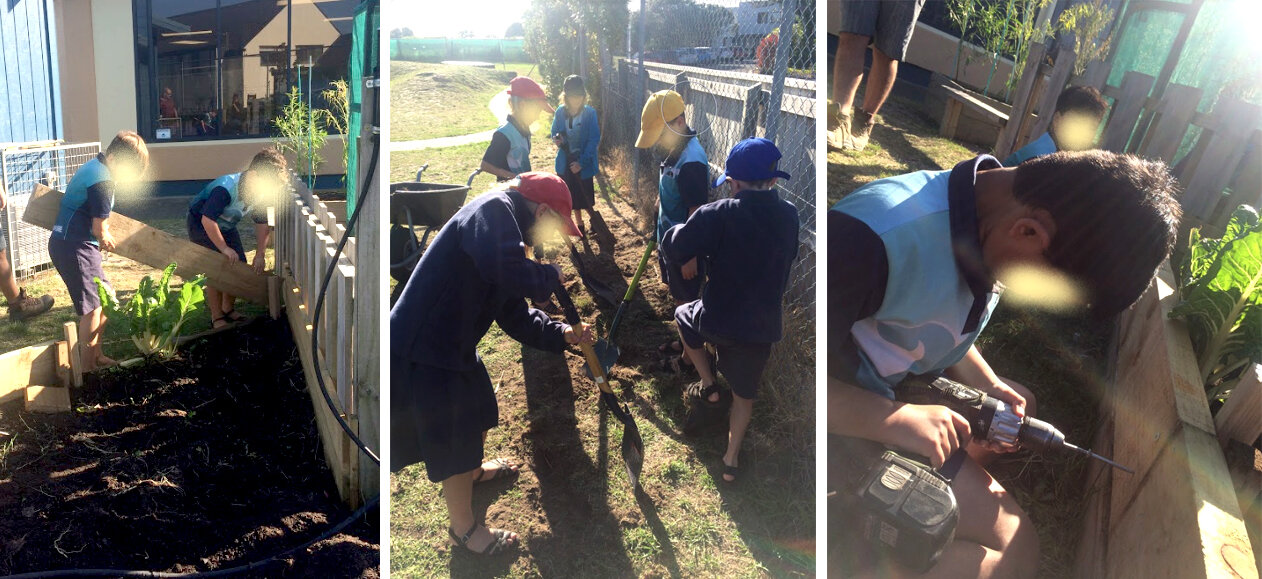March at St Thomas More
Wow! What a busy month we have had in the garden! I have been impressed with the amount of effort and hard work the kids at Saint Thomas More have put into reshaping and tidying up their garden! Ka mau te wehi! Fantastic work!
We started off the month discussing and researching garden designs. We spoke about how for a garden to be efficient, it’s a good idea to be able to reach in the back. We decided to shorten the width of one of our garden beds - that way, you don’t walk over or squash food that is growing in the front to get food from the back. We also spoke about the different parts of the plants and how the roots need space to grow. Collectively, we decided it would be a good idea to make the big garden bed deeper so the roots have more space. If the roots have more space to grow, the plants will grow bigger!
Additionally to this, we had a lovely parent helping us to revamp our big bed. Some kids got to use some tools like hammers, drills, levels and saws. What an experience! The kids were in charge of the project while adults watched over for safety. They did so well and were very proud of their work.
We also prepped the ground by removing the grass next to the fence. We are going to be building new garden beds once we get back to school and will plant species that like to climb! Using the permaculture principle ‘Use edges: Value the marginal’ we are putting it up against the fence and the fence will have a double purpose! Watch this space to see our results!
We also worked on rejuvenating our old garden beds by removing all of the invasive weeds. Unfortunately we had many! Including kikuyu, couch (pronounced ”kooch”), oxalis and black nightshade! Oxalis seemed to be the hardest - it’s the one that looks similar to a clover on the top - but it has a nasty bulb under the ground. If you don’t get the bulb it will just grow back! We made it a competition on who could find the most bulbs with some children finding over 100 each! Working together as a team, made the process a lot easier! Great team work everyone!
Once we got rid of all the invasive weeds, we worked on feeding the soil - “Feed the soil and the soil will feed you”. We applied blood, bone and seaweed then mixed it in. Finally, over 3 of our beds we planted green mulch. Green mulch is a cover crop of plants that you intend to “Chop and drop”. These plants cover the soil to suppress weeds while also growing roots that feed the soil. When our cover crops grow, we will chop them at the base (leaving the roots in the soil) then leave them on the ground where they fall. As these plants die, they feed all the good bugs in the soil. Did you know that a small handful of soil contains more than 1 billion microorganisms! They are teeny tiny bugs that you can’t see with your naked eye. You need to have a very specific microscope to see them. We managed to get our ground cover crops onto three of our beds before we had our lockdown due to Covid-19. When we come back, hopefully our ground cover crops will be cranking and ready to ‘Chop and Drop’.
Finally, we managed to finish shovelling soil into our large, revamped garden bed. Luckily, we had Mr Webster who planted our seedlings - that were growing on our windowsill - for us as our school closed suddenly. Mr Webster always puts a HUGE amount of effort into our garden days and we are very grateful! Thank you Mr Webster!
A special thank you to the adults involved in making this happen this month (you know who you are) and the amount of effort you have put in is incredible!
Thank you everyone!
PiPS Team





